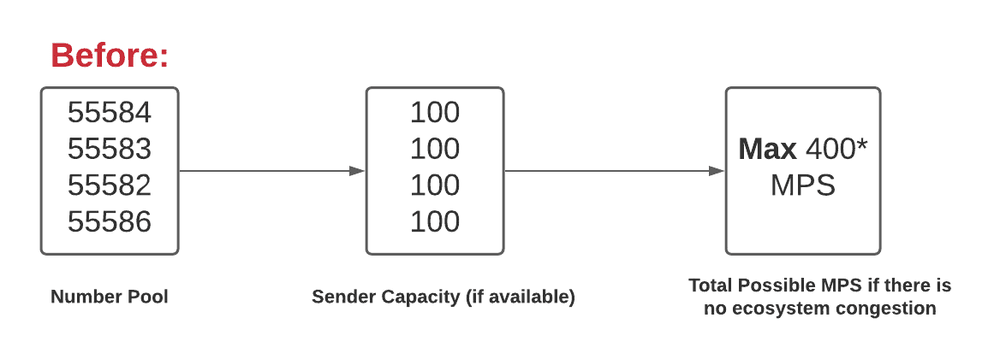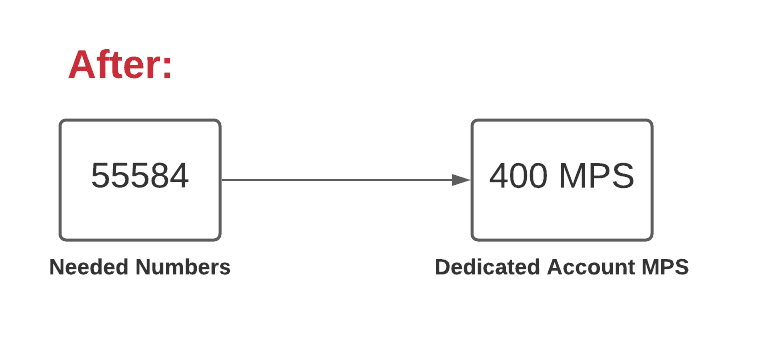Account Based Throughput Overview
Info
We are currently providing priority onboarding to Account Based Throughput for the highest sending volume customers.
Twilio is offering a new way to allocate throughput for Programmable Messaging (SMS and MMS). Account Based Throughput bases throughput limits on message volume across an individual account. Message volume is determined at the parent account level.
This guide will cover:
- A quick overview of what throughput is.
- How throughput was previously calculated.
- The benefits of the new Account Based Throughput.
- Rate limits and Message Queues.
- Account Based Throughput and A2P 10DLC
Let's get started!
Throughput is the rate at which you can send messages at a given time. It is measured per phone number, per second. Each type of phone number has a different throughput rate available to it. For example, Twilio short code numbers have a current available throughput of 100 Messages per Second (MPS).
The diagram below illustrates the way throughput was previously calculated:

In this example, the Customer has 1 Number Pool with 4 senders (short code numbers) inside of that pool. Each of these numbers has a Sender Capacity of 100 MPS, meaning each short code number can send a total of 100 messages per second. The available MPS for this customer's ecosystem is 400 maximum, if there is no traffic congestion.
But what if there is traffic congestion? If there is traffic congestion in the Twilio messaging ecosystem, with this throughput structure you won't hit your maximum throughput capacity due to too many messages being sent at a time.
Let's look at an example to visualize this situation:
Example
Imagine a busy highway during rush hour traffic. Even if the highway speed limit is 65 miles per hour (mph), during rush hour traffic you will only ever be able to go 30 mph so long as you're stuck in traffic behind all of those cars! This makes highway travel unpredictable, and heavily dependent on highway capacity at a given time.
Similarly to the highway traffic example, throughput was heavily dependent on available ecosystem capacity. You can see the difficulty that arises with this sort of throughput configuration:
- Constant purchasing of phone numbers (overprovisioning) with the expectation of increasing total MPS.
- Many throughput limits to monitor simultaneously across different phone numbers.
- 30001 Queue overflow errors: An error that occurs when a message has been queued for 10 hours and not sent.
Account Based Throughput overcomes these limitations by providing you with the ideal level of throughput across your account, as opposed to within individual phone numbers.
The diagram below illustrates how Account Based Throughput is determined:

Rather than needing 4 short code numbers to achieve a throughput of 400 MPS like in the prior example, you will now only need one number to achieve equivalent throughput. Your messaging capacity is set at the parent account level, not set by the amount of individual numbers you have. No matter how many (or few) numbers you have at the parent account level, they will share the account level throughput limit.
Ultimately, you'll use less phone numbers to achieve the same dedicated MPS as before. Additionally, your throughput is likely to become more predictable.
Let's look at an example to visualize the concept:
Example
Imagine taking a commuter train that adheres to tight schedules with consistent train speed. It may not be as fast as a highway drive with no traffic, but it's speed is consistent and faster than rush hour traffic on a highway. This makes travel by train ride more predictable.
Using Account Based Throughput offers additional benefits too:
- Simplifies phone number and throughput management.
- Provides a better control and throughput planning.
- Ensures low latency or deliverability issues during peak traffic days.
It is the maximum available capacity of message throughput on an account level. It sets a maximum capacity limit for each sender type (Short Code and Toll-Free) and channel (SMS and MMS). The account based rate limits are configured based on your historical peak send times.
Messages will begin to queue if you send message requests faster than your account-based MPS (message segments per second). These messages will be added to the correspondent account-level queue and then transferred to the phone number queue. Messages will persist in the queue for a maximum of 10 hours.
An important note is that there is a queue for each channel and sender combination. For example:
Owl Inc. has both short codes and toll-free numbers. Owl Inc also sends SMS and MMS traffic. This results in 4 queues.
Let's assume the following MPS limits for Owl Inc and all of its subaccounts:
SMS:
- SMS Short Codes = 500mps
- SMS Toll-free = 100mps
MMS:
- MMS Short Codes = 100mps
- MMS Toll-free = 25mps
This results in a maximum queue lengths of:
SMS:
- SMS Short Codes = 500mps, max queue length 18,000,000 segments
- SMS Toll-free = 100mps, max queue length 3,600,000 segments
MMS:
- MMS Short Codes = 100mps, max queue length 3,600,000 segments
- MMS Toll-free = 25mps, max queue length 900,000 segments
Account-based rate limiting acts as a ceiling for an account, so while it won't affect individual A2P campaign throughputs, it could affect an accounts collective A2P traffic. For more information, see our support article on Message throughput (MPS) and Trust Scores for A2P 10DLC in the US.